15 Stunning Wall Painting Ideas That Will Inspire Your Next Home Makeover
Are you staring at blank, uninspired walls, dreaming of a change? A fresh coat of paint is, without a doubt, one of the easiest and most impactful ways to completely transform a room, breathing new life and personality into your living space. But why stop at a simple solid color when a world of creative possibilities awaits? If you’re ready to move beyond the mundane and turn your walls into stunning focal points, you’ve come to the right place.
Forget boring beige and say hello to captivating colors, dynamic designs, and textures that tell a story. Whether you’re a seasoned DIYer or a novice looking for an easy weekend project, these 15 stunning wall painting ideas will ignite your imagination and inspire you to pick up a brush. Get ready to unlock the transformative power of paint and create a home that truly reflects your unique style!
Why a Creative Paint Job Matters
Before we dive into the ideas, let’s consider the impact of a well-thought-out paint design:
- Sets the Mood: Color and pattern can dramatically alter the ambiance of a room, making it feel cozy, energetic, calming, or sophisticated.
- Adds Personality: Your walls become a canvas for self-expression, showcasing your individual taste and creativity.
- Creates Focal Points: A unique paint treatment can draw the eye, highlighting architectural features or creating interest in an otherwise plain space.
- Defines Zones: In open-plan living, different paint treatments can visually separate areas and define their functions.
- Boosts Home Value: Thoughtful and well-executed design choices, including creative paintwork, can enhance the appeal and value of your home.
Now, let’s explore some incredible ideas to get your creative juices flowing!
15 Wall Painting Ideas to Elevate Your Home:
1. The Classic & Timeless Accent Wall: Simple Yet Striking
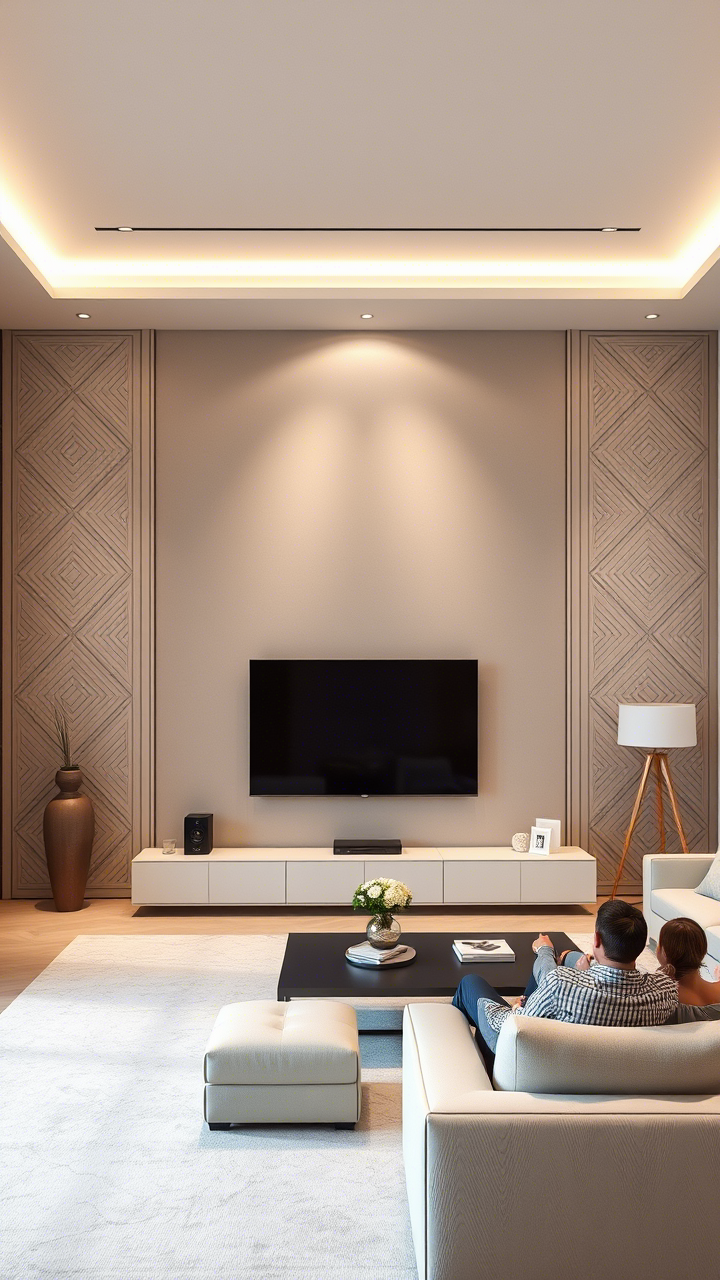
- The Idea: This is a perennial favorite for a reason. Choose one strategic wall in your room and paint it a different color from the others. This could be a bold, contrasting hue, a deeper shade of the main wall color, or even a complementary neutral.
- Why It’s Stunning: An accent wall instantly creates a focal point, adds depth, and introduces personality without overwhelming the space. It’s a fantastic way to experiment with a bolder color you might be hesitant to use on all four walls.
- Best For: Living rooms (behind the sofa or TV), bedrooms (behind the headboard), dining rooms, or any room where you want to draw attention to a specific area.
- Tips for Success:
- Choose the right wall – typically one without too many doors or windows, or one that naturally draws the eye upon entering.
- Consider the room’s lighting; a darker accent color might work better in a well-lit room.
- Ensure clean lines by using high-quality painter’s tape.
2. Geometric Marvels: Shapes for a Modern Edge
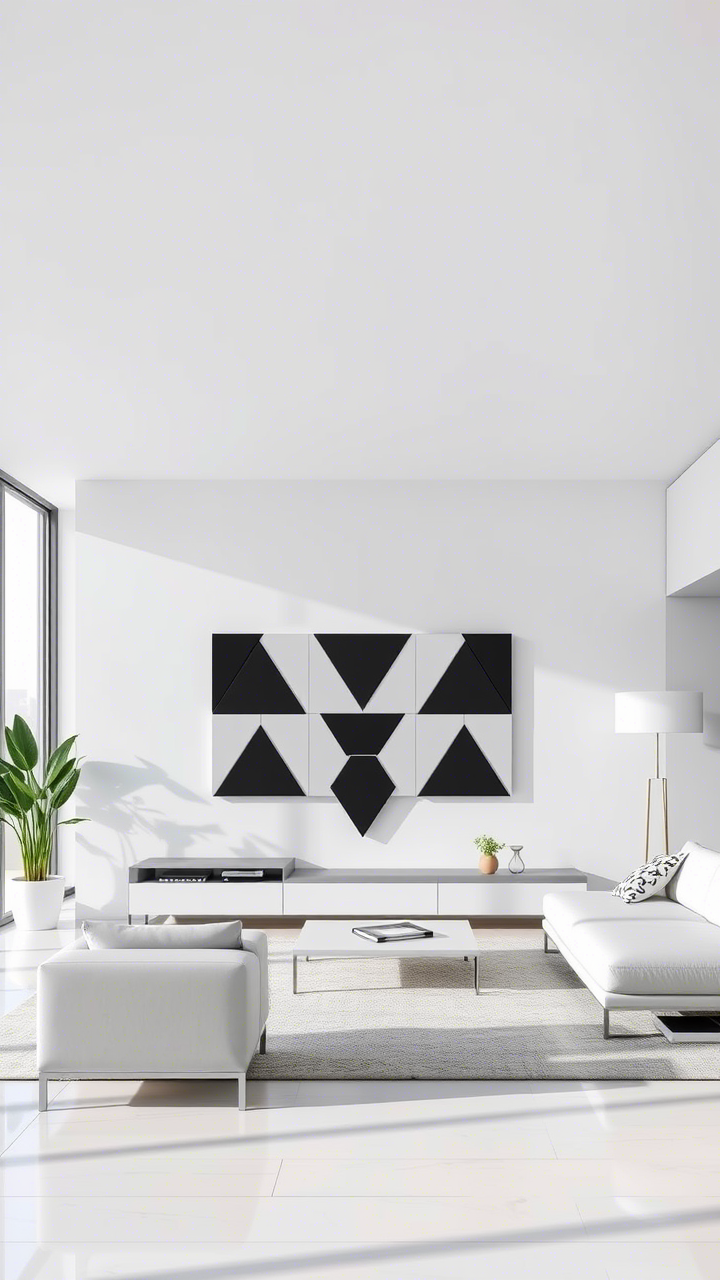
- The Idea: Embrace the power of lines and shapes by creating geometric patterns on your walls. Think triangles, chevrons, hexagons, stripes of varying widths, or even abstract angular designs. You can use a monochromatic scheme with different shades or go bold with contrasting colors.
- Why It’s Stunning: Geometric patterns add a contemporary, dynamic, and often sophisticated feel to a room. They can make a space feel more energetic and visually interesting.
- Best For: Modern living rooms, home offices, kids’ rooms (with playful shapes and colors), or as a feature wall in a bedroom.
- Tips for Success:
- Plan your design carefully on paper first.
- Use a level, measuring tape, and high-quality painter’s tape (like FrogTape for sharp lines) for precision.
- Paint one color section at a time, allowing it to dry completely before taping for the next.
- Consider the scale of the pattern in relation to the room size.
3. Soothing Ombre & Gradient Walls: A Soft Transition of Color
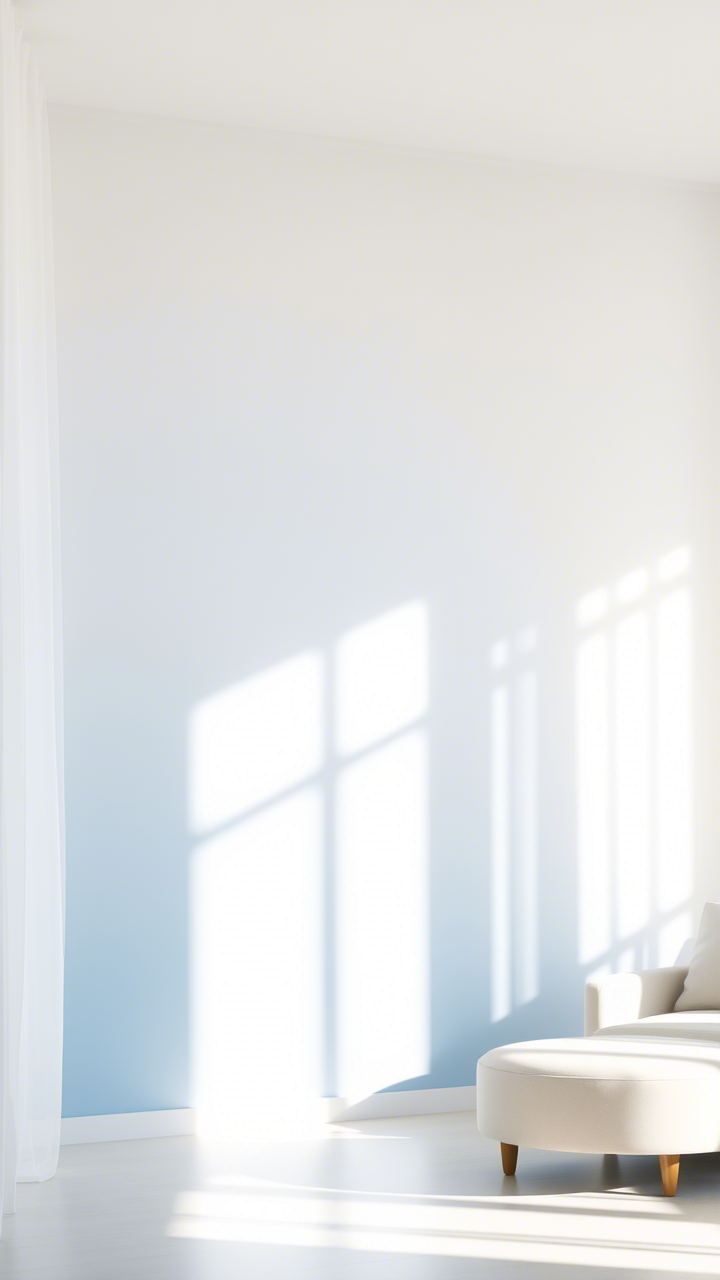
- The Idea: Create a beautiful, dreamy effect by blending shades of one color (or multiple complementary colors) from dark to light, or vice versa. The transition can be vertical (most common) or even horizontal.
- Why It’s Stunning: Ombre walls add a sense of depth, serenity, and artistry. The soft, gradual shift in color is visually calming and can make a room feel more spacious or taller, depending on the direction of the gradient.
- Best For: Bedrooms (especially for a relaxing atmosphere), nurseries, bathrooms, or any space where you want a subtle yet impactful feature.
- Tips for Success:
- Choose at least three shades of the same color (light, medium, dark) or analogous colors that blend well.
- Divide your wall into horizontal sections for each color.
- While the middle bands of paint are still wet, use a clean, dry brush (or a sponge) to blend the lines between the colors using soft, crisscross, or up-and-down strokes until the transition is smooth. This technique takes patience and a bit of practice.
- Alternatively, for a less blended but still gradient effect, paint distinct horizontal bands of color that are closely related.
4. Color Blocking: Bold Statements with Purpose
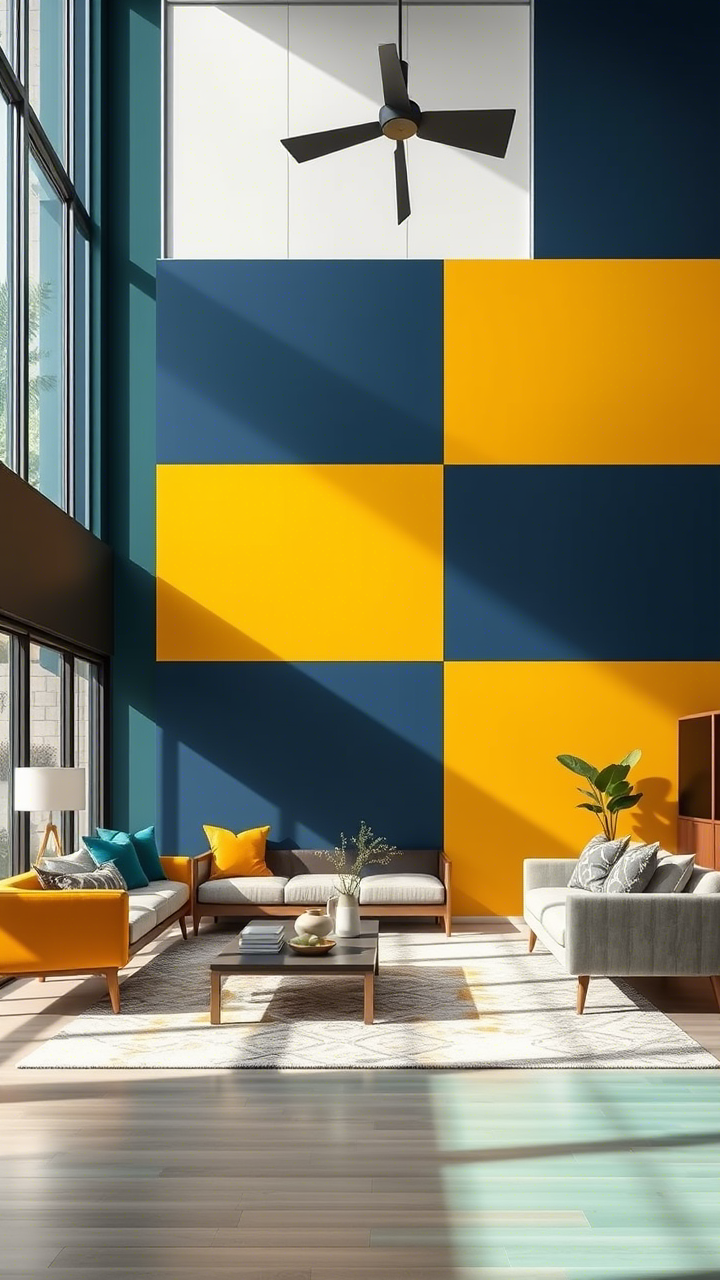
- The Idea: Similar to geometric patterns but often on a larger scale, color blocking involves painting large, distinct sections of a wall (or adjacent walls) in different solid colors. These blocks can be used to define zones, highlight architectural features, or simply create a bold graphic statement.
- Why It’s Stunning: Color blocking is a powerful way to inject personality and modern flair into a room. It’s confident, contemporary, and can be surprisingly effective at altering the perception of space.
- Best For: Open-plan living areas, kids’ playrooms, home offices, or to create a focal point around furniture like a desk or a bed.
- Tips for Success:
- Plan your blocks carefully. Consider how they will interact with furniture placement and the room’s overall flow.
- Use painter’s tape for crisp edges between color blocks.
- Choose colors that complement each other or create a deliberate, high-impact contrast. A neutral paired with a bold color often works well.
5. Half-Painted Walls (Two-Tone): Simple Chic & Space Defining
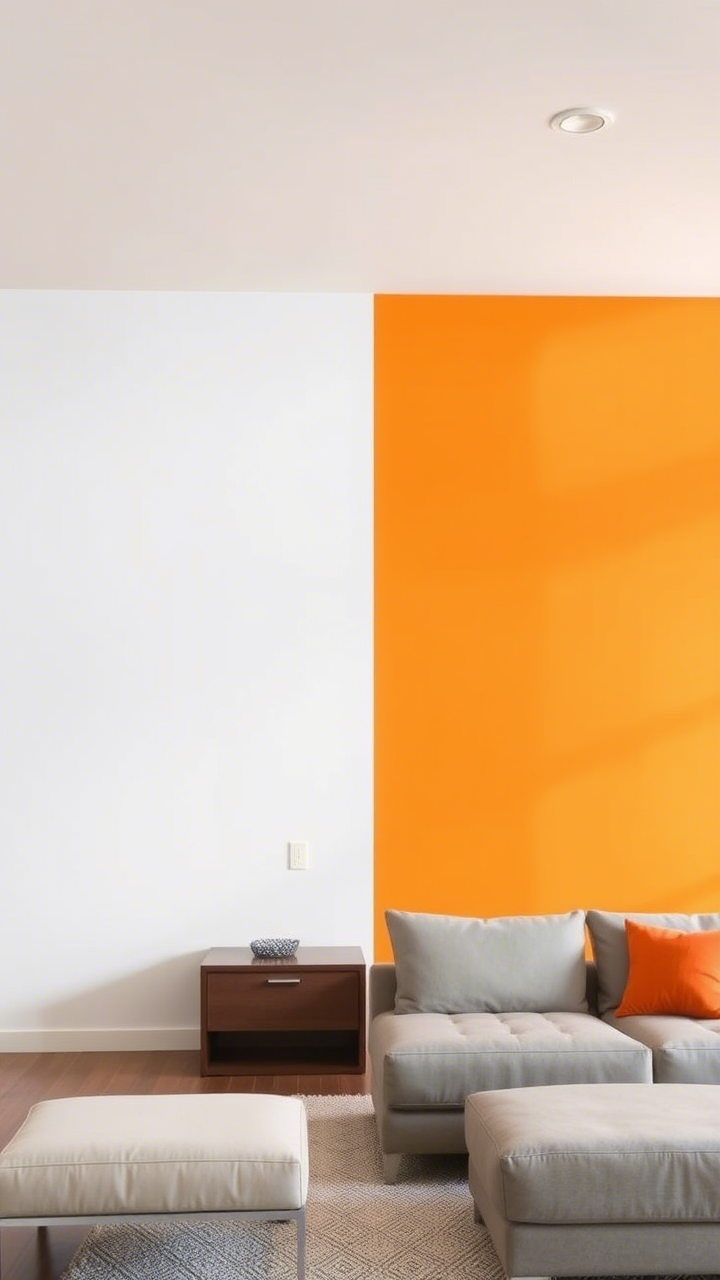
- The Idea: A simpler take on color blocking, this involves painting the lower portion of the wall one color and the upper portion another (often white or a lighter neutral, but not necessarily). The dividing line is typically horizontal.
- Why It’s Stunning: Half-painted walls add instant interest and can make a room feel taller (if the darker color is on the bottom) or cozier. It’s a modern take on traditional wainscoting and can ground the space beautifully.
- Best For: Dining rooms, hallways, bedrooms, nurseries, or any room where you want to add architectural interest without actual molding.
- Tips for Success:
- Decide on the height of your dividing line – common choices are one-third or two-thirds of the wall height. Use a level to ensure a perfectly straight line.
- Painter’s tape is essential for a sharp, clean division.
- Consider painting the darker color on the bottom for a grounding effect, which is also more practical for hiding scuffs in high-traffic areas.
6. Textured Paint Finishes: Adding Depth and Tactility

- The Idea: Move beyond flat color by introducing texture. This can be achieved with specialty textured paints (like sand, suede, or stone effects), by using specific application techniques (like sponging or rag rolling, though these should be approached with a modern sensibility), or by applying a skim coat with a subtle texture.
- Why It’s Stunning: Textured walls add warmth, depth, and a tactile quality that flat paint can’t achieve. They can hide minor wall imperfections and create a unique, organic, or even rustic feel depending on the texture.
- Best For: Living rooms, bedrooms, hallways, or as an accent wall to add a cozy, earthy, or sophisticated element.
- Tips for Success:
- Practice your technique on a sample board first, especially for faux finishes.
- Ensure the wall is properly prepared, as texture can sometimes highlight larger flaws if not applied carefully.
- Consider the room’s overall style – a heavily textured wall might not suit a very minimalist space unless it’s a deliberate contrast.
7. The Allure of a Painted Arch or Organic Shapes: Soft & Playful
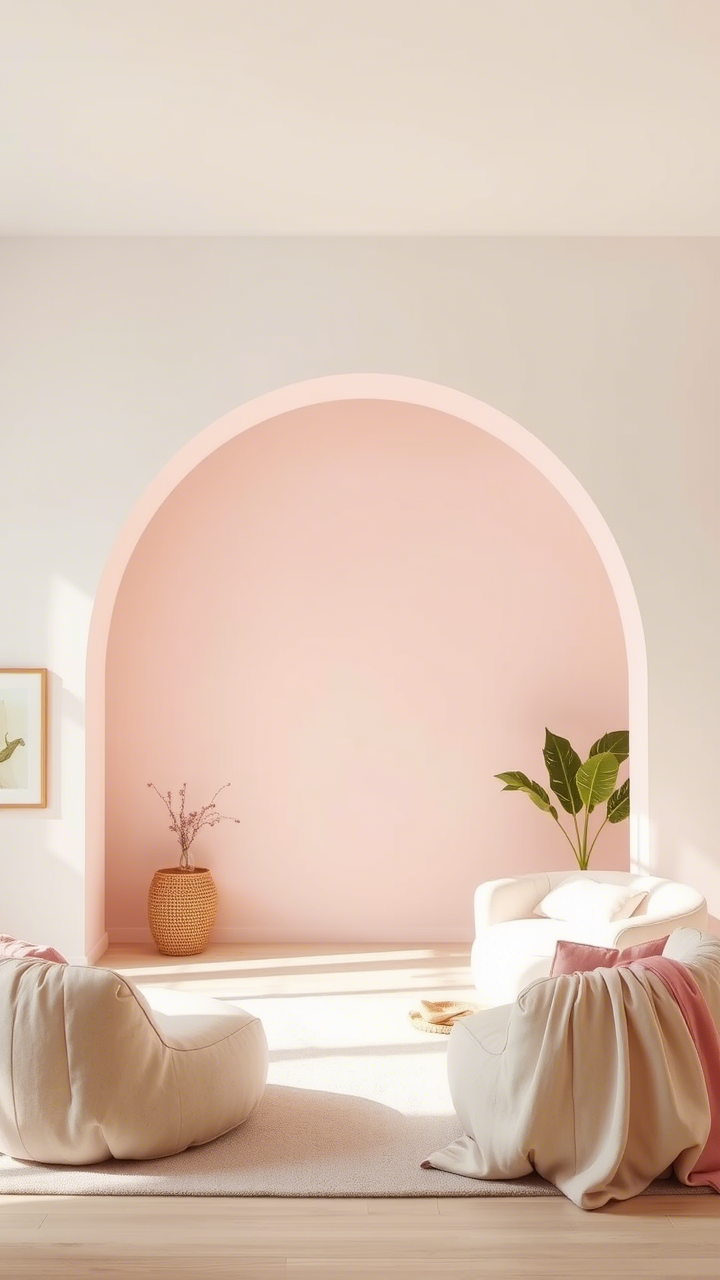
- The Idea: Break away from straight lines by painting a soft archway shape on a wall to frame a piece of furniture (like a headboard or desk), create a faux nook, or add an architectural illusion. You can also experiment with other organic, free-flowing painted shapes.
- Why It’s Stunning: Painted arches and organic shapes add a touch of whimsy, softness, and architectural interest without any actual construction. They are very on-trend and can make a space feel more curated and artistic.
- Best For: Bedrooms, nurseries, playrooms, home offices, or entryways to create a unique welcome.
- Tips for Success:
- To create a perfect arch, use the “string and pencil” compass method or trace around a large circular object for the top curve.
- Use painter’s tape for the straight sides and carefully freehand or use flexible painter’s tape for the curve.
- Choose a contrasting color for the arch to make it pop, or a slightly darker/lighter shade of the wall color for a more subtle effect.
8. Chalkboard or Whiteboard Walls: Functional Fun

- The Idea: Transform an entire wall, or a section of it, into a functional writing surface using chalkboard paint (available in traditional black and other colors) or whiteboard paint.
- Why It’s Stunning (and Smart!): This is a playful and practical idea that encourages creativity and organization. It’s perfect for jotting down notes, grocery lists, menus, inspirational quotes, or for kids to unleash their inner artists.
- Best For: Kitchens, home offices, kids’ rooms, playrooms, or even a feature wall in a mudroom.
- Tips for Success:
- Apply several thin, even coats of chalkboard/whiteboard paint according to the manufacturer’s instructions for best results.
- Properly cure the paint before use (chalkboard paint often needs to be “seasoned” by rubbing chalk all over it and erasing).
- Ensure the wall surface is as smooth as possible before application for the best writing experience.
9. Subtle Stripes: Vertical or Horizontal Elegance
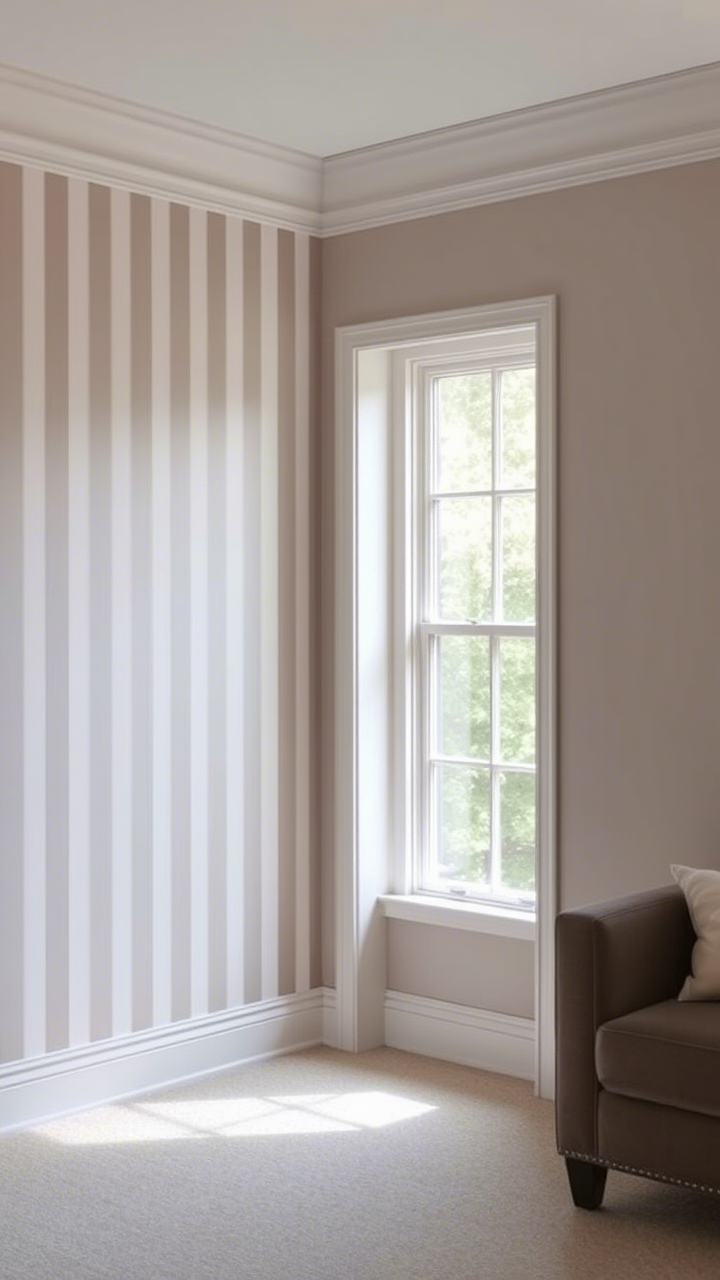
- The Idea: Painted stripes can elongate or widen a room, depending on their orientation. They can be bold and contrasting or subtle and tonal (using slightly different shades of the same color or different sheens of the same color).
- Why It’s Stunning: Stripes are a classic pattern that can add a touch of elegance, playfulness, or sophistication. Subtle, tone-on-tone stripes offer a refined texture and visual interest without being overwhelming.
- Best For: Living rooms, dining rooms, bedrooms, hallways, or even bathrooms. Vertical stripes can make ceilings appear higher; horizontal stripes can make a room feel wider.
- Tips for Success:
- Meticulous measuring and taping are key for straight, even stripes. Use a level.
- Decide on the width of your stripes and the spacing between them.
- For tone-on-tone sheen stripes (e.g., matte base with gloss stripes of the same color), the effect is most noticeable when light hits the wall.
10. Polka Dots or Confetti Walls: Playful & Whimsical
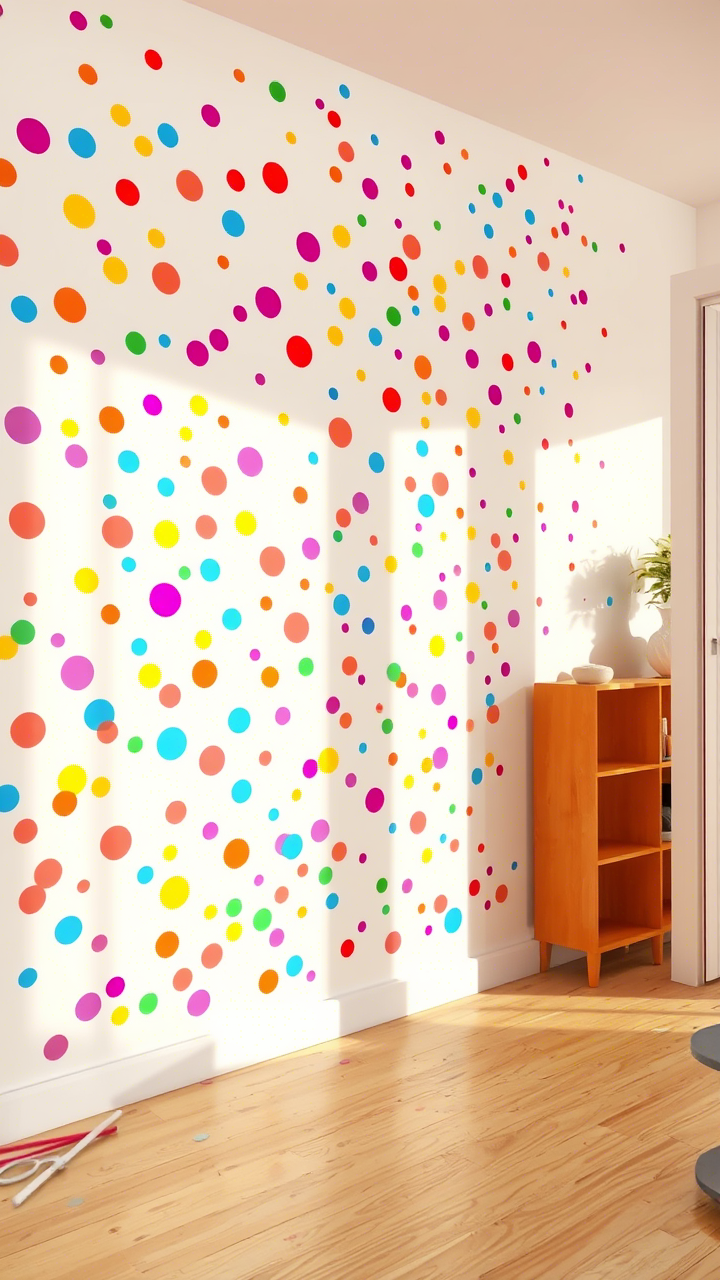
- The Idea: Add a dose of fun with painted polka dots or a more irregular “confetti” pattern. Dots can be uniform in size and spacing or varied for a more organic look.
- Why It’s Stunning: This is a cheerful and whimsical way to liven up a space. It’s particularly effective for creating a joyful atmosphere. Metallic dots can add a touch of glam.
- Best For: Nurseries, kids’ rooms, playrooms, or even a small accent wall in a craft room or laundry room for an unexpected pop of fun.
- Tips for Success:
- Use stencils (store-bought or DIY from cardboard or Mylar) for uniform polka dots.
- For a random confetti effect, use small craft brushes or even round pouncers in various sizes and colors.
- Plan your spacing, or embrace a more random, scattered application.
11. Mural Magic: Your Wall as a Canvas

- The Idea: For the truly artistic or those willing to hire a professional (or use large-scale decals/wallpaper murals as an alternative), a painted mural can transform a wall into a breathtaking piece of art. This could be a landscape, an abstract design, a cityscape, or a nature scene.
- Why It’s Stunning: A mural is a unique and deeply personal statement piece. It can transport you to another place, tell a story, or simply be an awe-inspiring visual feast.
- Best For: Feature walls in living rooms, dining rooms, bedrooms (especially calming nature scenes), or imaginative themes in children’s rooms.
- Tips for Success:
- If DIYing, sketch your design to scale first. Projectors can help transfer the image onto the wall.
- Use good quality artist’s acrylics or interior wall paints in sample pots.
- Start with the background and work towards the foreground details.
- If a full hand-painted mural is too daunting, explore high-quality wallpaper murals or large decals that mimic the effect.
12. The “Fifth Wall” Statement: Painting the Ceiling
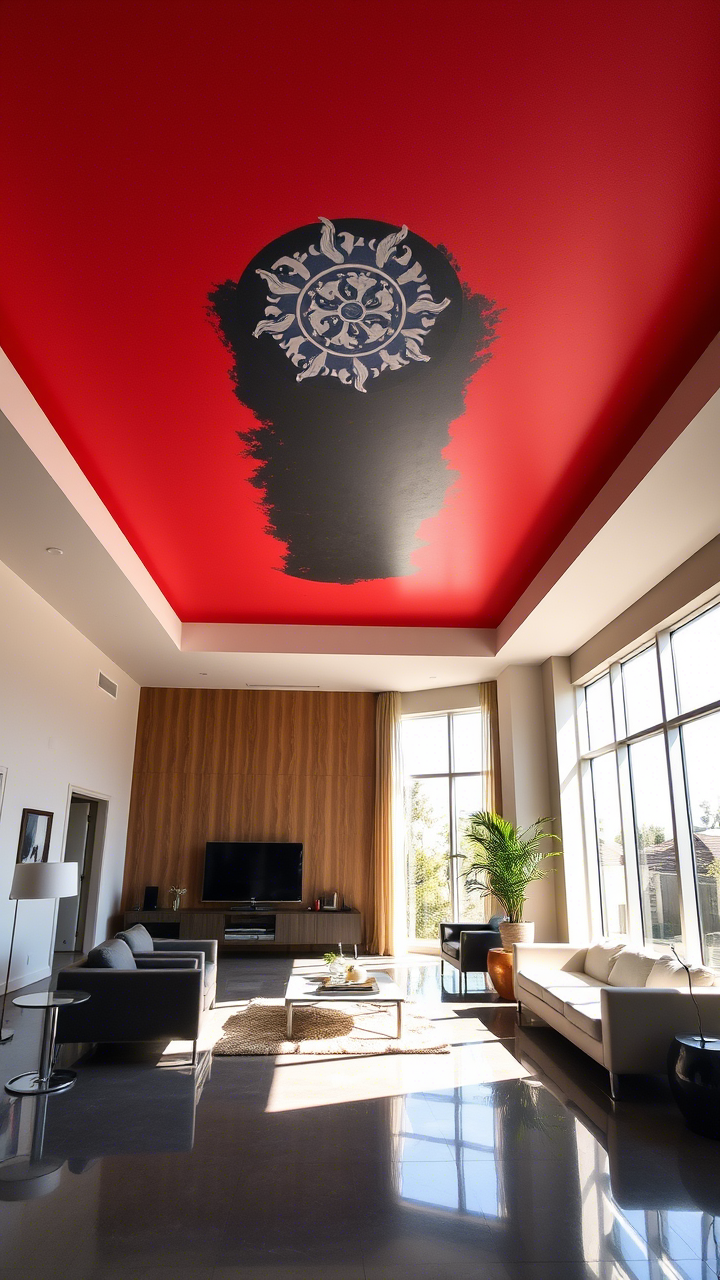
- The Idea: Don’t forget the ceiling! Painting it a color other than standard white can have a dramatic impact. This could be a pale shade that coordinates with the walls, a bold contrasting color, or even a metallic finish.
- Why It’s Stunning: A colored ceiling can make a room feel cozier (darker colors), more expansive (very light colors), or add an unexpected element of surprise and sophistication. It draws the eye upwards and can highlight architectural features like crown molding.
- Best For: Bedrooms (a dark, starry ceiling), dining rooms (a rich, warm color), or rooms with high ceilings where you can afford to be bold.
- Tips for Success:
- Consider the ceiling height. Dark colors can make a low ceiling feel even lower.
- Ensure the ceiling is in good condition, as color can highlight imperfections.
- Use a good quality roller with an extension pole and wear eye protection.
13. Nature-Inspired & Botanical Touches: Bringing the Outdoors In
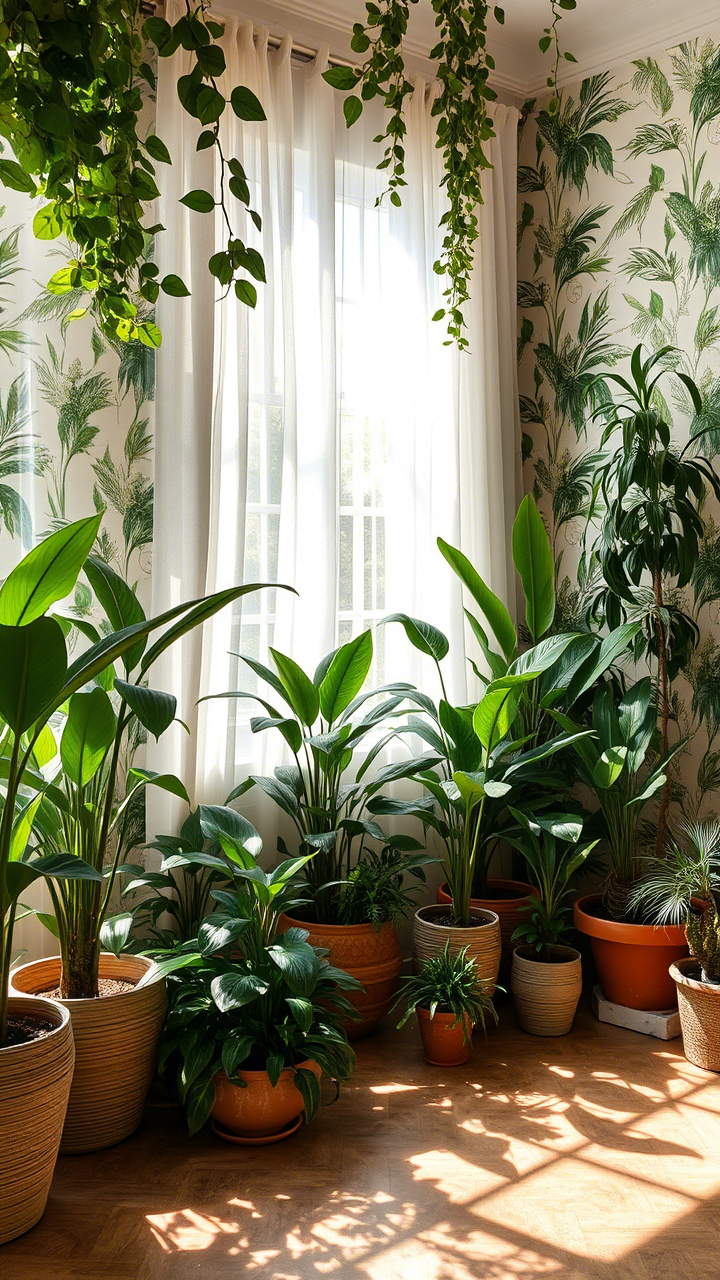
- The Idea: Create a calming oasis with nature-inspired painted elements. This could be as simple as a feature wall in a leafy green or earthy terracotta, or more intricate designs like painted vines, oversized leaves, or a subtle mountain range silhouette.
- Why It’s Stunning: Botanical and nature themes are inherently calming and grounding. They connect your indoor space with the natural world, creating a refreshing and serene atmosphere.
- Best For: Bedrooms, bathrooms, sunrooms, living rooms, or home offices where you want to foster a sense of tranquility.
- Tips for Success:
- Use stencils for repetitive leaf or vine patterns.
- For a mountain range, use painter’s tape to create jagged peaks, layering shades for depth.
- Choose a color palette inspired by nature – greens, blues, browns, and earthy tones.
14. Metallic Accents & Details: A Touch of Glamour

- The Idea: Incorporate metallic paints (gold, silver, bronze, copper) for an element of luxury and shine. This could be an entire metallic accent wall (use with caution, as it can be very reflective), metallic stripes, geometric shapes with metallic details, or even stenciled patterns using metallic paint.
- Why It’s Stunning: Metallic finishes catch the light beautifully, adding warmth, glamour, and a touch of opulence to a room. They can make a space feel more sophisticated and special.
- Best For: Dining rooms, powder rooms, bedrooms (as an accent behind the bed), or to highlight architectural details.
- Tips for Success:
- Metallic paints often require a specific base coat color for best results – check the manufacturer’s recommendations.
- Apply thin, even coats to avoid streakiness. A smooth surface is crucial.
- Consider the lighting in the room, as metallics will look different depending on how the light hits them. A little often goes a long way.
15. Minimalist Lines & Simple Color Washes: Understated Elegance
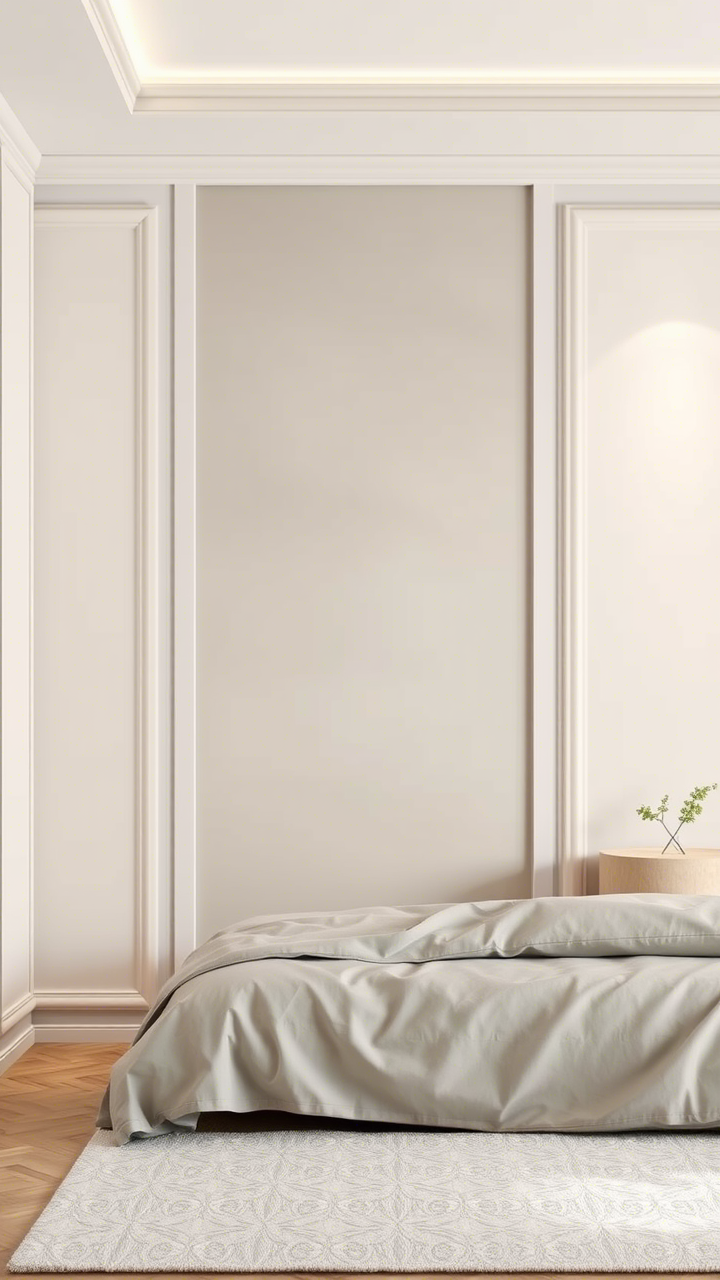
- The Idea: For lovers of minimalism, a subtle yet impactful approach can be achieved with very fine painted lines that create a delicate pattern or a soft color wash technique for a watercolor-like effect.
- Why It’s Stunning: This approach embodies “less is more.” It adds a touch of artistry and texture without overwhelming the space, maintaining a clean and serene aesthetic. A color wash can add depth and a gentle, organic feel.
- Best For: Minimalist or Scandinavian-style interiors, bedrooms, meditation spaces, or any room where a calm, uncluttered look is desired.
- Tips for Success:
- For fine lines, use a very thin artist’s brush and a steady hand, or specialized fine-line painter’s tape.
- For a color wash, dilute your paint with water or a glazing medium (check paint compatibility) and apply with a brush or sponge in soft, overlapping strokes over a lighter base coat. Practice on a sample board first.
Your Walls, Your Canvas – Time to Get Creative!
Painting your walls is an opportunity to infuse your home with your unique personality and style. Don’t be afraid to step outside your comfort zone and try something new. Whether you opt for a bold geometric design, a soothing ombre effect, or a playful chalkboard wall, the key is to choose an idea that resonates with you and complements your home’s overall aesthetic.
With a bit of planning, the right tools, and a dash of creativity, you can transform any room from drab to fab. So, which of these stunning wall painting ideas will inspire your next home makeover? Pick up that paintbrush and let your imagination lead the way!
Frequently Asked Questions
- Q: How do I choose the right paint colors for my design idea?
A: Consider the mood you want to create (e.g., calming blues, energetic yellows), the amount of natural light the room receives, your existing furniture and decor, and basic color theory (complementary, analogous, monochromatic schemes). Always test sample pots on your wall in different lighting conditions before committing. - Q: What’s the best type of paint to use for detailed wall designs?
A: For most interior wall designs, a good quality acrylic latex paint (water-based) is suitable. It has low odor, dries relatively quickly, and cleans up with soap and water. For very fine details or murals, artists’ acrylic paints can also be used, but ensure they are compatible if layering with wall paint. - Q: Do I need to be an artist to attempt some of these more creative ideas?
A: Not at all! Many stunning effects, like accent walls, half-painted walls, simple stripes, or using stencils for polka dots or geometric shapes, are very DIY-friendly and rely more on careful measuring and taping than artistic skill. For more complex murals, you can use projectors or large decals. - Q: How important is surface preparation before starting a creative paint project?
A: Extremely important! A clean, smooth, and properly primed surface is crucial for any paint job, but especially for designs with sharp lines or multiple colors. Fill holes, sand imperfections, clean the walls thoroughly, and use a good quality primer appropriate for your surface and paint. - Q: What are the essential tools for most of these creative wall painting ideas?
A: Key tools include: high-quality painter’s tape (various widths, and perhaps specialty tapes like FrogTape), good paintbrushes (angled sash brushes for cutting in, various artist brushes for details), paint rollers and trays, a level, a measuring tape, a pencil, drop cloths, and good quality paint and primer. For specific designs, you might need stencils, a projector, or specialized texturing tools. - Q: How can I ensure crisp, clean lines for geometric patterns or stripes?
A: Use high-quality painter’s tape. After applying the tape, burnish (press down firmly) the edge that will receive paint using a putty knife or credit card to create a tight seal. For an even sharper line, consider painting the base color along the edge of the tape first (let it dry) before applying your new color; any bleed-through will then be the base color. Remove tape when the new paint is still slightly tacky, pulling it off slowly at a 45-degree angle. - Q: How can I ensure crisp, clean lines for geometric patterns or stripes?
A: Use high-quality painter’s tape. After applying the tape, burnish (press down firmly) the edge that will receive paint using a putty knife or credit card to create a tight seal. For an even sharper line, consider painting the base color along the edge of the tape first (let it dry) before applying your new color; any bleed-through will then be the base color. Remove tape when the new paint is still slightly tacky, pulling it off slowly at a 45-degree angle. - Q: Can I combine multiple of these painting ideas in one room?
A: Yes, but do so thoughtfully to avoid a visually cluttered or overwhelming space. For example, you might have an accent wall with a geometric pattern and then paint the other three walls a complementary solid color. Or, combine a half-painted wall with a subtle textured finish on the upper or lower section. The key is balance and cohesion. - Q: How do I fix mistakes if my painted design doesn’t turn out perfectly?
A: Don’t panic! For small smudges or bleeds, you can often touch them up carefully with a small artist’s brush once the paint is dry. If a line isn’t straight, you may need to let it dry, sand lightly, re-tape, and repaint that section. For larger issues, you might need to repaint the affected area or even the entire wall. Remember, it’s just paint – it can always be changed! - Q: How long should I wait for one color to dry before taping over it to paint another color for a design?
A: This is crucial for preventing damage to the fresh paint. Most latex paints will be dry to the touch in a few hours, but they take longer to cure fully. Wait at least 24 hours (or longer, as per the paint can instructions, especially in humid conditions) before applying painter’s tape over a newly painted surface. Using a “delicate surface” painter’s tape is also recommended for freshly painted areas.


Leave a Reply